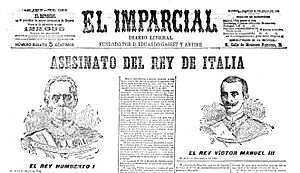El Imparcial (1867–1933) facts for kids

Former headquarters of the newspaper
|
|
| Type | Daily newspaper |
|---|---|
| Founder(s) | Eduardo Gasset y Artime |
| Founded | March 16, 1867 |
| Language | Spanish |
| Ceased publication | May 1933 |
| City | Madrid |
| Country | Spain |
| ISSN | 2171-0244 |
El Imparcial was an important daily newspaper published in Madrid, Spain. It was printed from 1867 to 1933. The newspaper had a liberal way of thinking. This means it supported ideas like individual rights and freedoms.
It was started by Eduardo Gasset y Artime. El Imparcial was one of the first newspapers in Spain owned by a company. Before this, most newspapers were run by political groups.
A Newspaper's Beginning
El Imparcial began on March 16, 1867. When it first started, about 25,000 copies were printed each day.
By 1890, it had become one of Spain's most important newspapers. The newspaper itself said it was sold "even in the smallest villages." It was also sold in big cities like Paris, London, and Buenos Aires.
At the start of the 1900s, it printed about 130,000 copies daily. This made it very popular.
El Imparcial was the most widely read and influential newspaper during the time Maria Christina of Austria was ruling Spain. However, it started to lose some of its good reputation. This happened partly because its director, Rafael Gasset Chinchilla, became a government minister in 1900.
The newspaper's main office moved over time. It started on Calle Mesonero Romanos. Later, it moved to a building designed by Daniel Zavala Álvarez in Madrid.
A special part of the newspaper was its cultural section, called Los Lunes (The Mondays). For many years, this was the most important cultural section in the Spanish language. Famous writers like Miguel de Unamuno and Pío Baroja often wrote for it. These writers were part of a group known as the Generation of '98.
The 20th Century and Changes
In late 1903, there was an idea to combine El Imparcial with a magazine called Blanco y Negro. But this plan did not work out.
In 1906, El Imparcial joined with two other newspapers, El Liberal and Heraldo de Madrid. They formed a large publishing group called the Sociedad Editorial de España, also known as "the Trust."
Among these three newspapers, El Imparcial was seen as more conservative. It appealed to a wealthier audience. "The Trust" became a very powerful group in publishing. However, in March 1916, El Imparcial left the group. It was not making enough money from the partnership.
After leaving "the Trust," the Gasset family took control of the newspaper again. But they could not increase sales or improve its financial situation.
In its final years, General Luis Bermúdez de Castro helped manage El Imparcial.
After the Second Spanish Republic was declared, the newspaper's political views changed. From mid-1932, it supported the Radical Republican Party. This party was led by Alejandro Lerroux. However, by March 1933, it started to support ideas closer to the monarchy (having a king or queen).
El Imparcial had a smaller audience in its last years. It stopped being published in May 1933.
See also
 In Spanish: El Imparcial (1867-1933) para niños
In Spanish: El Imparcial (1867-1933) para niños



